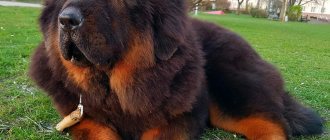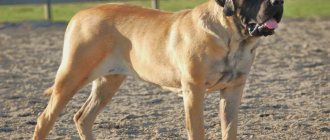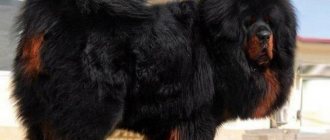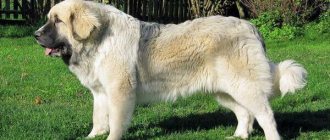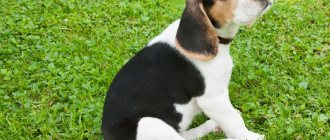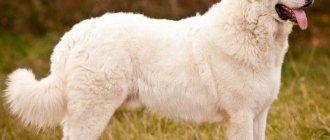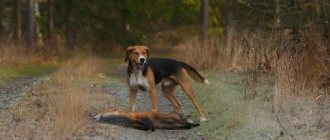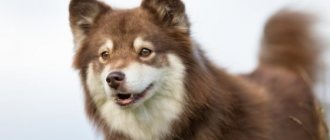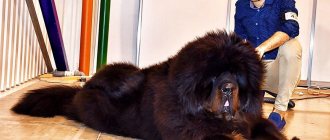Not many people know about this breed of dog, the Tibetan Mastiff. Indeed, today it is quite rare. This breed belongs to the group of Swiss mountain and cattle dogs, Molossers, Pinschers and Schnauzers. What was the Tibetan Mastiff originally bred for? This breed is the most ancient working breed. Dogs belonging to it were used in Tibetan monasteries as guard dogs, and nomads, whose habitat was the Himalayas, valued them as their faithful helpers.
Origin story
You can understand where the Tibetan mastiff comes from from its name. The natural conditions of the mountains are known to be quite harsh. Because of this, Tibetan Mastiffs had to become strong and resilient in order to successfully adapt to their environment. In the mountains they were not influenced by the outside world, thanks to which the breed retained its purity and its strong qualities.
The first mentions of Tibetan mastiffs date back to ancient times. Aristotle had a chance to meet these dogs when he traveled through Asia. Mastiffs and Marco Polos have been noted. These researchers described the breed in their writings, praising the animals' fortitude and endurance. Other travelers also admired the Tibetan mastiffs. There is an assumption that it was from this breed that the Molosser group was subsequently formed.
Despite its ancient origins, the mastiff appeared in Europe only in the 19th century. The dog was presented as a gift to the Queen of England. Somewhat later, Edward VII brought two more such dogs from his trip to Asia. In 1898, the first litter of Tibetan mastiffs appeared in the Berlin Zoo in Europe.
Interesting Facts
The Tibetan Mastiff is without a doubt one of the largest dogs. However, there is evidence that in former times the size of some individuals of this breed was comparable to that of a donkey.
These dogs are considered the most expensive on our planet. Thus, in 2009, the price for a Tibetan Mastiff puppy was set at 600 thousand dollars (a little more than 40.6 million rubles), and relatively recently one Chinese billionaire paid 10 million yuan for a young dog of this breed. This amount is 1.5 million dollars, or 101 million 536 thousand rubles.
There is a legend according to which the owner of such a dog was Buddha himself.
The Tibetan mastiff is so strong that there are cases when he won fights between wolves and snow leopards.
Having long and lush hair, the dog sleeps peacefully in the snow. She can also spend a long time in bad weather or on ice.
The Mastiff is considered an excellent watchdog. In former times, these dogs were kept on a leash during the day and released at night to protect the territory from enemies and predators. This way of life is not alien to Tibetans even in modern times. They have not lost the habit of dozing during the day and being active at night.
Breed standard
The Tibetan Mastiff's coat is thick and smooth. This is why animals can be kept outdoors all year round without any problems.
An adult Tibetan mastiff reaches a weight of 60-80 kg. At the same time, the height at the withers of the dog is 60-77 cm. The upper limits of these indicators remain open for the Tibetan mastiff. The main thing for the breed is maintaining the required proportions.
Training a Tibetan Mastiff
The dogs are well trained and raised. The main indicator is the strength of character of the owner, who can show his perseverance and show due patience.
Please note that the Tibetan Mastiff must be trained from the very childhood of the dog. Otherwise, you may have problems adjusting your pet's behavior, and it will be more difficult to cope with it. In order for the puppy to quickly learn commands and obey you, follow the basic rules - do not hit, scare the animal or shout at it. This behavior will only turn the animal against you and may cause him to behave aggressively. And the most correct answer to the question - how to raise a mastiff - will be only one - the dog must be placed in the hands of professionals. Only professional trainers who are familiar with the characteristics and characteristics of this breed can raise an adequate family member for you.
Head
What makes the Tibetan Mastiff different? Strong, voluminous and heavy head. An adult Tibetan Mastiff may have folds between the corners of the mouth and the eyes.
The massive skull of individuals of this breed is rounded at the top and square at the bottom. The bump on the back of the head, as well as the transition from the muzzle to the forehead, are clearly visible in these dogs. What proportions should the individuals have? Compliance with the breed standard is the distance from the occipital protuberance to the transition of the muzzle to the area of the forehead called the stop. It should be equal to the distance from the same stop to the nose. In some cases it is acceptable for the muzzle to be slightly smaller.
As for the jaws, ideally they have a straight or scissor bite. A purebred dog's teeth are always complete and tightly set. The lower jaw is closed with pronounced lips.
The Tibetan Mastiff's eyes are wide apart. According to the breed standard, they should be medium in size, oval in shape and slightly sloping. Tibetans have a proud and impressive expression in their eyes. The eyelids cover the eyeballs quite tightly.
The dog has hanging triangular ears. They are located at the level between the skull and eyes. The ears are covered with soft short hairs and are of medium size; they are slightly tilted forward and slightly raised if the dog is in an excited state.
The neck of the Tibetan Mastiff is quite powerful, with well-developed muscles. It has the shape of an arc with a small dewlap (skin folds).
Appearance of the Tibetan Mastiff
Tibetan Mastiffs look as majestic as the mountains where they come from. These are powerful and strong dogs with very massive and strong bones. They have a large head framed by a shaggy mane. The expression of the muzzle is expressive, and the look of the dark eyes is unusually penetrating and serious. The breed is hardy to physical stress and resistant to harsh weather conditions. Moreover, this dog is a real giant. The standard does not set an upper limit for the growth of Tibetan Mastiffs. But males should not be lower than 66 cm, and females - 61 cm. The weight corresponds to the proportions of the dog.
The height of the tallest Tibetan mastiff named Shi-Lung reached 90 centimeters. And the heaviest representative of the breed is Big Splash. At the age of 11 months he weighed 130 kg.
The head of the Tibetan Mastiff is wide and strong. There is a characteristic fold behind the eye line; it appears in adulthood. The difference between the forehead and muzzle is clearly visible. A wide nose with large nostrils should be dark. The muzzle is square in front, the lips cover the lower jaw. Scissor bite only. The eyes are brown, rather wide and slightly slanted. The dog looks openly, with a sense of self-esteem. The ears are triangular in shape and hang forward. When the dog is alert or excited, the ears are slightly raised.
Neck with a strong scruff and well-developed muscles. There is a small suspension. There is a thick and long maned collar around it. The dog's body is stocky, the back muscles are well developed. The chest is deep and quite wide. The fluffy tail is located high, and when moving it is thrown over the back. The limbs are smooth and strong, overgrown with thick hair. The paws are large and round in shape. The mastiff moves at a leisurely pace, easily and springily on any surface. His push is powerful, his balance is good, and his endurance is high.
The quality of the coat is very important for this breed. It should be straight and rough, but at the same time thin, with a dense undercoat. Curly, wavy, or silky hair is not acceptable. Males are more shaggy. There is especially abundant hair on the neck and shoulders, where the mane forms. Long thick hair on the tail, fluffy “pants” on the hind legs.
The color can be solid black and blue, as well as with tan. Dogs with fur of red and golden colors and their shades, sable, are especially valued. Allows a small white patch on the chest and markings on the feet. There may be dark “glasses” on the muzzle.
Serious defects in the exterior include poor physical shape, too lightweight head, large jowls and dewlap, overly large ears, light eyes and nose, ring-shaped tail, unbalanced movements, height 2 cm less than the minimum limit.
Dogs with bite defects, aggressive and timid dogs are subject to disqualification. And also with a color not specified in the standard. The following colors and patterns are not acceptable: white, lilac, gray, cream, liver, brindle, spotted.
Frame
The Tibetan Mastiff is distinguished by a muscular back and a straight line of the spine. The body of a dog of this breed has a rather voluminous, flat-shaped croup. The chest, reaching the elbow joints, is of medium volume. The ribs when curved resemble the shape of a heart. The breed standard contains the proportions of the ratio of the length of the body of an individual to its height. The first parameter should be slightly larger than the second.
The tail of the Tibetan Mastiff has a high set and medium length. It is located at the level of the spine line. If the dog is alert or excited, it raises its tail and easily throws it over its back.
Wool
The quality of the Tibetan Mastiff's coat is much more important than its quantity. Moreover, females generally have fewer hairs, while males have more. The coat of purebred Tibetan mastiffs should not have waves or curls, and should also be soft and silky to the touch.
A distinctive feature of the breed is its luxurious mane. It looks like a lion's and covers the shoulders and neck of the dog. In the upper part of the hind legs, the covering looks like a kind of pants.
Tibetan Mastiff puppy prices
It is unlikely that you will be able to buy a mastiff puppy in a transition or on the market - the breed is too rare. Therefore, you will have to contact the nursery.
The cost of a dog depends on the size of the puppy and the characteristics of its maintenance. If we talk about the average price, it starts from 30,000 rubles. Naturally, by setting such a price, the breeder guarantees that the baby is healthy, vaccinated, meets the requirements of the breed and other characteristics. It is clear that the seller is obliged to confirm his words with documents - certificates, pedigree.
There are a number of useful tips and recommendations that you should pay attention to when buying a Tibetan Mastiff:
- Don't save money. If you decide to buy a dog that is not a pure breed, but cheaper, then you risk adopting an aggressive and unbalanced animal.
- Regarding choosing the gender of a puppy, breeders say the following: “It is better for inexperienced dog lovers to take girls.” Accordingly, a person who is familiar with raising dogs first-hand can try his hand at raising a male Tibetan Mastiff.
- Don't forget about things like pedigree and other documents. Make sure that the puppy does not have a predisposition to any hereditary disease.
Only after completing the formalities, proceed to choosing a puppy. Better take the most lively baby.
Color
Tibetan Mastiffs can be:
- black;
- black and tan;
- blue;
- blue and tan;
- golden with a tone from fawn to rich red;
- sable
Tan marks can be of various shades - from red to dark brown. Depending on the coat, the dog's eyes have a brown tint. The standard says that the darkest eye color is the most preferred. Mastiffs should also have black lips and noses.
Appearance
According to the standard, the color of the breed can be black, black with tan, brown, golden or gray. Various variations of tones of the presented shades are allowed. Males of the Tibetan Mastiff have a height at the withers of within 70 centimeters, females - within 60 centimeters. The weight of dogs ranges from 60 kilograms.
The Tibetan Mastiff is a large, tall dog with a strong build. A distinctive feature of the dogs is their luxurious long coat with a well-defined undercoat, which protects them from undesirable weather conditions.
The length of the body is slightly greater than the height at the withers. The eye color usually matches the coat, but may vary slightly; the lips should cover the lower jaw. The fur on the neck is similar to the mane of a lion. The tail is of medium length and rises slightly above the back. The paws of the Tibetan Mastiff are muscular and round in shape.
Breed Features
Due to the fact that Tibetan mastiffs were kept in only one closed area for many centuries, the breed remained strong and healthy. Adults practically do not get sick.
The optimal conditions for keeping a Tibetan mastiff are outdoors. Dogs feel better in a backyard. Of course, apartment owners can also get such a breed, but it will be much more difficult. The Mastiff will require long walks to satisfy its exercise needs, as well as more careful training.
In addition, in a city environment, the dog will have to adapt to a variety of smells and sounds, to the noise of the streets, to people with children passing by, to loud groups of teenagers and to other animals. In addition, the fur of an individual living in an apartment will not be as luxurious and thick as that of mastiffs who are constantly outdoors.
One of the great advantages of the breed is the absence of the smell characteristic of dogs. Even those people who suffer from allergies to wool can have such animals. The pet will not cause any concern for those who cannot stand the smell of “dog” in the house.
The main decoration of the breed is its coat. How to care for a Tibetan Mastiff so that the coat remains healthy and thick? It is worth noting that this is not difficult at all. All you need to do is perform standard hygiene procedures that do not take much time from the owners. These dogs shed only once a year.
The Tibetan Mastiff is perfect for our harsh northern climate. And this is thanks to his good health, excellent immunity and thick coat. A dog that lives on a personal plot does not need to be allowed into the house, even if it is thirty degrees below zero outside.
Mastiff puppies are very touching and cute. They resemble teddy bears. Like all kids, they are playful, restless and active. However, an older dog becomes balanced and calm.
The process of raising a Tibetan Mastiff should begin as early as possible. This way puppies quickly adapt to humans and the outside world. However, you should not overload the kids. Until they are 1-1.5 years old, they should not receive too much stress. Growing dogs have fragile bones, and because they grow quickly and weigh quite a lot, they need to be protected from all kinds of injuries.
The Tibetan Mastiff (we discuss caring for it in the article) is a territorial animal. The dog perfectly protects both its owners and the square meters provided to it, namely a vegetable garden, a plot or even part of a street. Having settled on their territory, mastiffs choose the highest point on it, from which they observe what is happening and perform their guard duty.
Free fragment - Chronicles of the Tibetan Mastiff
Chronicles of the Tibetan Mastiff - what is this book about?
Until the 20th century, Europeans imagined Tibetan mastiffs as monsters of antiquity rather than as pets. Even today, in the 21st century, the history of the breed is shrouded in legends about the half-dog, half-lion. Until now, some people clearly see bears in the “Tibetans”.
In fact, the Tibetan Mastiff today is a pet, a family favorite, the owner of the sofa, whatever you want to call it. But not a monster and not a monster at all. And yet, raising such a dog has its own characteristics.
“Chronicles of the Tibetan Mastiff” is a series of phantasmagoric stories about the everyday life of a Tibetan mastiff living not in China or even in Europe, but on a farm in Russia. Despite all the exoticism of its breed, our Shanghai feels quite comfortable here in Russia. He tries to keep the neighbor's bugs at bay and does not miss the opportunity to put the belly on every guest.
About the life of the Tibetan mastiff in the Leningrad region - in this book!
Tibetan Mastiff: journey from Beijing to St. Petersburg
Last year a dog appeared in our family. This animal comes from China. We bought a Tibetan mastiff puppy 100 kilometers north of Beijing. Today he is an adult male. Before him, we had a shepherd dog, a Doberman, and then a Labrador that is still alive today. One way or another, the Tibetan mastiff turned out to be much more unique than we could have imagined. In general, first things first.
The Tibetan Mastiff is considered one of the most expensive breeds today. Not so long ago, puppies of this family lived exclusively with Chinese moneybags. Long before this (20th century), animals came under a new state policy, according to which luxury should not even be taxed. It just needs to be destroyed. Almost all owners of “Tibetans” were under attack. Today, interest in this family is growing. But it doesn't come without troubles. In 2012, breeders of the breed began to leave the market. The fault lies with the latest ideological trends adopted by the Chinese authorities. Today, a Tibetan puppy is considered a luxury in China. Breeders of this breed (along with the owners of high-end restaurants and jewelry stores) are subject to unaffordable taxes. According to the government, this should reduce the percentage of corruption in the country.
One way or another, one of these furry babies ended up in our yard. Shanghai (that’s the dog’s name) managed to surprise even me.
Shanya was taken straight from Beijing by plane in a large pet carrier to St. Petersburg. In Russia, he was transported to live in the lap of nature - to the dacha. Our family farm is adjacent to it. Today Shanghai faithfully serves chickens, turkeys and goats.
In one of the programs dedicated to the “Tibetan,” his owner talked about the remarkable intelligence of dogs of this breed. They say that they, unlike most dogs (and many people) are able to measure strength. It really is! Despite the fact that the breed was used in the past as a guard breed and they began to make it a “family” breed relatively recently, in any case, the “Tibetans” really know how to balance their strength.
In addition to Shani, a Labrador and a cat live on the farm. Despite the obvious differences in size, Shani and Donut (that’s the cat’s name) have no problems. The dog does not chase the cat, does not poke his nose, and has never encroached on the peace of the little furry. The best illustration is a real incident that happened to me and Shanghai.
It was during the day. I just served myself homemade pilaf and sat down at the dining table. About 10 minutes had passed since the start of the meal when someone pinched my soft spot. There were two dogs and a cat in the house. I turned around - Shanya was looking at me with the eyes of “a dog that saw everything.” Everything except my pilaf, of course. He almost told me “Your food is my food. Let's eat." Let them cook rooster meat for Shani every day. Everything tastes better from someone else's plate! The point is that if a dog of the Tibetan Mastiff breed wanted to bite me, the matter would not be limited to a “pinch.” The “Tibetans” really know how to balance their strength. How many dogs we had - all of them, seeing a person having dinner, whined, drooled, and began to talk. Whatever! But not a single dog in my memory has ever thought of pinching me.
By the way, due to the specific structure and size of the organs, the bark of Tibetan mastiffs is especially loud. If I were asked to explain this sound, I would say that it is polyphonic, unlike the barking of dogs of other breeds. Shani's bark is deeper and louder than that of the same Labrador. This is where the “amazing things nearby” are just beginning. According to Friend magazine, these dogs are so intellectually developed and have such a strong-willed character that they can be taught to dance. At all kinds of special breed exhibitions you can witness the “mastiff dance”. The dancers' owners claim that the "Tibetans" are not robot dogs. In the process of learning the dance, they can offer their own steps. Our Shanghai, either fortunately or unfortunately, gravitates more towards security activities.
The price of Tibetan Mastiff puppies is legendary. According to one of them, the most expensive “Tibetan” cost its owner several million dollars. This is because this breed is considered the heritage of China. Tibetan mastiffs in this country are something like a nesting doll, Cheburashka and a hat with earflaps in Russia. In short, this dog family in China is a national treasure. Several years ago, the average price for a Tibetan puppy in China was 175,000 rubles. Our Shanghai was more expensive. But it's not about the numbers.
One way or another, the Tibetan Mastiff is a unique breed of dog. These are the so-called “cat's paws”, and a booming bark and, of course, a lot of fur. If desired, you can knit socks from it that will not mind the Russian frost. Tibetan mastiffs also eat very little.
I haven’t told you even half of the interesting things about this breed. This dog family can be described better than a thousand words by a quote from the direct owner of Shanghai: “This is a large, unpretentious and warm guard.”
A day in the life of a Tibetan mastiff
06:53
My day starts with a light walk in the backyard. The first thing I do when I go outside is to inhale the fresh aromas of nature. I know for sure that somewhere in the neighborhood there has been a new addition to the family of bipeds - from the side of the neighbor’s house there is a smell of baby powder. Deep in the forest, a fox tore to pieces a chick that had fallen from the nest. She's going to have a nice lunch today.
07:30
Even though I am one of the rarest dog breeds, I am a simple farm dog. Immediately after breakfast I go for a morning inspection of my territories. Those that my bipeds entrusted to my protection.
First of all, I check if everything is okay with the quails. These guys don't stop talking for a minute. Their males peel off the backs of females with their clawed paws. If you keep them in a spacious enclosure, they will kill each other. Therefore, our quail family lives “in crowded conditions but not in any harm,” as they say here in Russia.
Behind them, in their enclosures smelling of grass and milk, come the goats. We keep the breeding goat, as required by artiodactyl etiquette, in a separate room.
Adele is the oldest. Older (but not wiser) than her is my brother-from-another-mother, Twin Labrador. Adele knows many adventure stories. Every time I go to see her, she manages to tell me one of them. Next to her, her sister, Beauty, is vomiting from doing nothing. This goat's skin is a nice shade of red, almost like myself. She has no stories at all, but she knows a lot of interesting things from the life of her neighbors: who eats what, who doesn’t like whom, and which dogs live where. Also an interesting artiodactyl.
In the same room there is an aviary for turkeys. Busy guys. And delicious. They make such funny sounds - something between the cooing of a pigeon and the way the velociraptors from the movie “Jurassic Park” talked to each other.
10:25
My brother-from-another-mother and I love to hang out in front of the TV. Sometimes laziness completely takes over our bodies and we lie near the “box” until lunchtime.
As for today, nothing worthwhile was shown on TV. The owners left on one of those channels that is intended purely for human viewers. Twin and I love Animal Planet. Our favorites are Cesar Milano and Planet of Sharks.
I myself can’t change channels because my fingers are too wide (all my texts are typed on the keyboard by a laying hen) and my mouth is not designed to control the TV remote control. Actually, Twin could handle this. His relatives are able to carry an egg in their mouths without it breaking. But not our Twin. He will definitely try to play with this egg like a ball. He’s generally “special” to us—that’s what Donut, my other brother-from-another-mother, says. This is a British Blue cat. He considers Twin and me nothing more than guests in his house.
If the TV shows nothing but a bespectacled woman with an enema or syringe in her hands, we leave our beds and run for a walk. Twin finds a toy that he wants to play with and for some reason (in a completely magical way) suddenly, suddenly, unpredictably, it turns out to be necessary for me too. This is how our “funny fights” begin. He buries his nose in the fur on my neck, and I try to snatch a rubber circle - one of our toys - from his mouth. I don’t even notice how lunch time comes.
12:30
Natalya, the woman who is looking after us, is trying to treat me to a piece of bun. I refuse. She insists. I still refuse. She insists again. Twin comes over and swallows a piece of the bun. I call this time of day “Despair”.
I make a “goat face”, saying that I didn’t really want this bun. It's actually very disappointing.
13:25
It's time to check out the breeding goat - Mario. He lives in a separate enclosure from the goats. Sometimes he gets very stubborn when the farm keepers come to him to clean his enclosure. On such days, the men take Mario out of the enclosure and leave him to graze right in the yard.
Mario is a strong goat. One day he wanted to play and after a couple of runs he tore down one of the walls of his old enclosure, where Beauty lives today. It’s scary to even imagine what this goat of the Anglo-Nubian breed is capable of if you anger him. However, I hope we will never know. Mario is a good goat. Even when he starts butting heads, I know he doesn't mean anything bad to anyone.
The bulls who participate in bullfights do not at all want to harm the matador. Biped scientists have already guessed that the bull is just playing in this way. However, this does not mean at all that I would not be afraid to be in the same enclosure with Mario when he is not at ease. I'm telling you: Mario is a very strong goat.
15:45
At this time, all the people disappear from the house. And I use it.
The second floor is closed to me. There, in human territory, only Donut lives among the tailed ones. The owners installed an “anti-dog” barrier - something like a metal gate on a latch. So they don’t want to let me into their bedrooms, living room and, oddly enough, their dressing room.
While my bipeds are scattering in all directions, I am implementing another plan to enter the forbidden territory. While I’m trying, if not to fly, then at least to climb over the obstacle, Donut is lounging on the sofa and watching with genuine interest my attempts, if not to break the system, then at least to break the latch!
17:35
At this time, all my people, one way or another, find themselves at the dinner table. There are gadgets and malnutrition, however, the atmosphere is quite warm. At such moments, I prefer to doze off on my favorite red sofa. People will never drive me away from it anyway - I’m too fluffy for negativity. As for Twin, at this time he is begging people for food. Chicken, vegetables, something else from their plates. Let it be spinach! He will be happy to beg him too.
18:30
After a hearty lunch, my people return to their gadgets and social networks. I occasionally attract their attention by trying to get into their accounts in the form of a photograph.
The Tibetans, the people who were the first masters of my ancestors, believe that I, a Tibetan mastiff, have supernatural powers. Legends claim that my ancestors and relatives protect not only the material property of their people, but also their mental health. The evil eye, damage, curse - the wide chest of the Tibetan mastiff saves a person from all this. We, “Tibetans,” see right through even the most cunning enemy hiding behind a mask of friendliness.
My task, like a dog, is to protect not only chickens and goats or a TV with a stereo system. It is my responsibility, as a dog whose breed’s roots go back to ancient times, to protect my people everywhere and always. Including where I physically cannot be.
I am not able to surf the Internet and check everyone who in one way or another ends up on the pages of my family members. And yet I can protect my two-legged creatures from the evil eye. It usually requires a photograph of a person. And, logically, today you can easily get it on the Internet. I can't stop ill-wishers from taking over photographs of my people. But I can stop them from jinxing them! When my person posts a photo with my image in his album on one or another social network, no one, not even the most powerful magician, will be able to encroach on the well-being of my two-legged one. All the curses, evil eyes and damage that a photo of my man posted on a social network can attract, my photo will reflect back - on the one who dared to encroach on my man. However, such protection becomes possible only on the condition that the owner still posts my photo.
23:55
It seems that it worked! My man pokes his tablet in my nose. He shouts something about three hundred huskies. I asked Twin why they need so many huskies when they, our bipeds, already have us? My brother-from-another-mother just shrugged.
And you? Posted a photo of your favorite dog?
What are you dreaming about, Tibetan mastiff?
Greece has everything. Everything here is in perfect harmony. Local society is ruled by logic - the most accurate and impartial science of all disciplines that has ever existed. The Greeks are divided into slaves and their owners. The wisest Greek - Aristotle - considers this state of affairs completely normal. He gave his name to the caste of the ruling Greeks, which gave rise to a new word for the Greeks - aristocracy.
Alexander the Great himself is listed as one of Aristotle's students. Modern historians believe that it was thanks to this friendship that the world avoided complete conquest by the Greek commander. Aristotle instilled in the student an interest in nature, its laws and all kinds of inventions for life outside the laws of nature.
During the life of Alexander the Great, the world was much less explored than it is today. Only Aristotle “knew” that the Earth was round. Before him, the philosophers of that time believed that it rested on three pillars and had a flat shape. It would not be an exaggeration to say that Aristotle made a humanist out of a tyrant. Lectures on life and the laws of nature awakened in Alexander a respect for life, and not for war.
The student learned a lot from his teacher during such conversations. And only once did a student surpass his teacher.
A certain Indian king gave Alexander the Great something that had never existed in Greece before. Neither overseas dishes, nor precious stones, nor even new territories - none of this could compete with such a gift. In the future, Aristotle will also write about him.
What Alexander the Great received from the Indian ruler that day is valuable to this day. Not every modern resident is able to afford this wonder. As for Alexander, he tried to study the gift inside and out. Fortunately, from childhood he differed from his peers in his desire to explore nature rather than satisfy bodily impulses. Therefore, he managed to learn more about this creation of nature itself than anyone could afford then.
Alexander left his chambers. He didn't know why, but he needed to get out into the fresh air. He passed all the balconies, windows and exits to the street. His feet led him either to the stable or to the barn. It seemed that only animals could live in these conditions: there were no beds, no dishes, not even servants - there was nothing in this part of the royal palace. Alexander had already turned around to leave when a rustling sound reached his ears. Having gone through wars, conquered cities and countries, and subjugated civilization, he was afraid to move. The rustling intensified. The Macedonian had to make a lot of effort to turn towards the noise coming from behind him.
There, in the depths of this room, or barn, stood three boxes covered with burlap. Alexander took a step forward. The swarming in all three boxes intensified. It’s as if there, in a cage covered with burlap, is hiding something alien even to the most enlightened philosophers of Greece, both today and tomorrow. With each new step of Alexander, the rustling became more and more distinct. It seemed that this sound permeated the air of the room - it was around Alexander, until, finally, it suddenly died down.
The sandals of the great commander, the conqueror of the world, buried themselves in one of the cages. My toes felt the warm steam coming from under the burlap. Alexander tore the rough cloth from the cage.
It seemed as if darkness itself lived inside her. Something black, prickly, breathing was there. Formless darkness, chaos - that’s what Alexander the Great saw in that cell. In a fit of anger, he tore the fabric from the remaining two cages. There, two pairs of burning eyes glowing in the dark stared at him. Filled with blood, incinerating anyone who displeased the Creature, they watched Alexander.
The creature that Alexander saw first took shape. Instead of a chaotic “something,” another pair of eyes looked at the Greek, from which ears hung on the sides, turning into the body, and from under it, massive and fluffy, paws stretched across the entire cage, maybe a bear, maybe a tiger. Alexander saw all sorts of creatures under the sun in his campaigns, the purpose of which was to educate the uneducated inhabitants of the world about Greek culture and philosophy, however, he saw something like this for the first time.
Alexander opened the cage. His interest in conquest was too strong. He acutely felt the need to understand, realize, cognize this unknown being - to master the same knowledge that probably only God possesses on this matter. It is possible to conquer not only quite tangible territories, it is also pleasant to possess such ethereal concepts as knowledge.
The bear's paw stepped onto the floor. The creature's lion's mane trailed behind her. After that is the dog’s body, ending with a bushy tail. The creature walked forward and stopped. The gazes of man and animal met.
- Who are you? - asked the man.
- I have many names.
- Tell me them.
- Dokui, Shakui, Bear, Lion, Dog...
“Molossian,” the man interrupted him. - You are a Molossus. That's what they'll call you here in Greece. - Alexander assured him. - Where are you from?
- I came down from the mountains. Buddha himself created me to help his people survive in the difficult conditions of Tibet.
The man nodded politely.
- Now you will help us Greeks.
- Will I guard?
- You will fight. Against our enemies. Here in Greece prayer gives way to philosophical thought. And philosophical thought becomes decrepit from being in a narrow space. She needs new followers - otherwise she will die here. With you we will expand the territories of distribution of Greek thought. There will be more like-minded people - the path to truth will be shortened, the man suddenly realized. - Legends will be made about you. For generations, people will tell their descendants about your family. You will become the hero of songs and chronicles...
— I’m already in one. The Chinese are ahead of you.
— China is not Greece and vice versa. You will live forever, no matter how long you have to walk on this earth.
Molossus fell into deep thoughts. He lay down in front of Alexander, folded his front paws into a cross and thought.
He is meditating, the Greek understood.
Dog character
These are not easy animals. Their character has its own characteristics. Judging by the reviews, it is better to get a Tibetan Mastiff for those people who already have experience in keeping and raising these dogs. After all, it will take a lot of effort from the owner to make his pet obedient. From a very young age, the Tibetan Mastiff needs to be instilled with a love for people. And at the same time, it must be trained persistently so that the animal’s obedience is perfect.
Judging by the reviews, the Tibetan Mastiff keeps its aggression under control. But at the same time, the dog is willful. If you raise a puppy correctly, the adult will become a good friend and a wonderful nanny for children.
The Tibetan Mastiff feels very good around a person. After all, the dog is very social. She becomes attached to the owner and then wants to be with him everywhere and always, joyfully responding to the offer to play.
By its temperament and character, the Tibetan mastiff is kind and calm. These are discreet animals that are friendly towards other dogs. Nevertheless, if they notice even the slightest manifestation of aggression, they are quite ready to give an adequate response at any moment.
Due to their guard mission, Tibetans are a little reserved and suspicious of strangers.
In terms of their level of intelligence, mastiffs resemble Great Danes. They are very smart, but at the same time they like to be stubborn.
The character of the Tibetan Mastiff is quite expressive and bright, friendly and unusually harmonious. This dog has never been accused of being a loose dog. Experts compare the voice of this animal with the deep and dull beat that a copper gong makes. In China, for example, the velvety timbre of the bark produced by Tibet was especially appreciated. And for this purpose, the dogs were specially given heated milk. But the mastiff rarely gives voice. He will not burst into senseless barking to scare a passerby he doesn’t like. Even without this, the dog will be able to stand up for its loved ones and for itself.
Due to its character, the Tibetan Mastiff is able to make independent decisions in certain situations. So, when a guest comes to the owner, the dog understands that there is no danger, and he will calmly move aside. However, in cases where an ill-wisher comes to the house, Tibet will boldly rush to the owner’s defense. This happens thanks to the unusually developed intelligence and instinct of the animal. Even Tibetan sages confirmed these qualities. They said this dog never sleeps. Indeed, the animal guards its owner so sensitively that if danger arises, it will instantly wake up and immediately begin active actions.
The character of the Tibetan mastiff does not allow him to bother a person with importunity. The dog will run around the area, lazily chill in the shade or lie in the sun, without approaching the owner. But as soon as he shows affection, Tibet will respond to it, and will do it with great pleasure. Kind words, stroking and touching have a calming effect on the dog. At the same time, communication with the owner and with all household members gives the mastiff great joy.
Due to its character, the Tibetan Mastiff unconditionally obeys the person who is in charge in the house. The rest of the family members receive loyalty, respect and affection from the pet. The big furry pet has a brave and loyal heart. There is enough for all the people he loves. And how happy he is when his owners return from work or a trip! This character trait should be taken into account by anyone who dreams of being greeted by a loving and devoted pet upon arriving home.
How does the Tibetan Mastiff relate to children? If there is a child in the house, then the dog is perfectly aware that there is a little fool in front of it. No amount of childish pranks, fussing or pestering can cause aggression in a Tibetan. Experts agree that in this case you will have to think about the peace of the dog, and not about the safety of your child. The baby can pat the Tibet, climb up to the animal with caresses, run after it, sit astride it. The Mastiff will only endure it philosophically. Little guests who come to the child and form a noisy company will have to explain that a playful fuss can be mistaken by the dog for a fight, which will give it the right to intervene to restore order.
Another remarkable character trait of the Tibetan Mastiff is its sense of dignity, expressed in the majestic poise of the animal. But at the same time it would be wrong to call the dog a phlegmatic person. After all, this pet is distinguished by its mobility and curiosity, playfulness and liveliness of mind, and in addition to all this, it has a sense of humor. The animal exhibits all of the above character traits in accordance with the current situation. So, when the family is alone with the dog, despite its gigantic size, it behaves like a playful and gentle kitten. In the presence of unfamiliar guests, Tibet is an attentive observer. He doesn’t get in the way, but at the same time constantly controls the situation. When danger arises, the mastiff turns into an unrivaled guard. But the most important character trait of this animal is devotion and fidelity, which it literally radiates with its gaze, movements and every cell of the body.
Nutrition
It is believed that mastiff owners have a sufficient level of wealth to support the dog. For health, the formation of a powerful skeleton, and increased muscle mass, any Great Dane breed needs a large amount of animal protein.
There are two nutrition options: artificial and natural. If in the first case you should focus on high-quality holistic food, then in the second case everything is much more complicated.
The dog owner must calculate the diet and select it according to needs so that all elements are in moderate quantities. The following components must be included:
- fermented milk products that form the musculoskeletal system, gastrointestinal tract;
- animal proteins are necessary for the growth of muscle tissue;
- fresh fruits and vegetables are a source of vitamins and microelements.
Dogs regularly include raw eggs and grated root vegetables in their diet plan. Among the dogs there are those who like to crunch carrots and gnaw cabbage leaves. Some people prefer fresh berries.
The mastiff will like porridge based on meat broth from cereals: buckwheat, pearl barley, rice, millet, egg and wheat. Boiled meat and offal are added there. The liver, heart and tripe of beef are useful. Occasionally, you can give the organ complex of the upper respiratory tract of a sheep, which consists of the throat, trachea, and lungs. Raw meat is a source of helminthic diseases, so it is advisable to pour boiling water over it.
You should absolutely not feed the following foods:
- pork due to its high fat content;
- potatoes (raw or boiled) for starchy reasons;
- lard, butter - a source of cholesterol;
- bread, pastries, confectionery products due to the high content of carbohydrates, sweeteners, glucose.
No matter how much you want to pamper your pet with sweets, try to resist. From an early age, you need to raise your puppy in a spirit of strictness, and not feed “from the table.” The Mastiff knows how to make cute faces while begging for goodies. Remember this is a dog, not a person. She has her own food.
Hygiene and care
Your pet's thick coat will require extra attention. After all, its cover is the pride of the breed. In addition, Tibet will need to ensure hygiene of nails, teeth, ears and eyes. How should you care for your dog?
- During shedding, the dog's fur must be combed three times a day, using special brushes.
- It is enough to bathe your pet twice a year.
- If tangled balls of hair or tangles appear, they are carefully cut off.
- It is recommended to brush your dog’s teeth twice a week for preventive purposes, and when changing them, constantly monitor the condition of the gums and the formation of the bite.
- The animal's claws are trimmed with special devices twice a month.
- After returning from a walk, you need to inspect the Tibet's paws, rinse them with clean water and wipe them with a soft cloth.
- You can remove accumulations of dust or wax from your ears by wiping them with wet wipes.
- The mastiff's eyes should be washed periodically using an infusion of chamomile.
Content Features
Many people who bought a Tibetan Mastiff are perplexed as to why their pet, unlike the neighbor’s puppies, plays little and sleeps very often. In fact, this is normal for a dog of this breed. Mastiff puppies grow quickly, and this takes a lot of energy. Therefore, the animals do not frolic, accumulating strength for full development. Therefore, do not interfere with the natural process, trying to wake up and stir up the animal against its will.
Dogs are completely unsuited to living in the city. A spacious country house with a large paddock for active walks is perfect for them. Tibetan Mastiffs have incredibly luxurious coats with an additional thick undercoat.
If you don’t have this opportunity, then walk with your pet several times a day, at least for 20-30 minutes.
You need to carefully care for your small Tibetan Mastiff:
- Check your skin for scratches and wounds.
- Clean your baby's eyes and ears.
- Teach him to hygiene.
Among other things, you need to brush your teeth a couple of times a week.
Most puppy care procedures will fall away on their own over time. As soon as the dog grows up, he will begin to take care of himself in many ways.
If you decide to get a Tibetan Mastiff puppy, you should be prepared for the fact that you will need to brush the dog daily. During molting, it will require even more careful and labor-intensive care. Caring for the coat of a Tibetan Mastiff is a rather difficult and time-consuming process. Dogs need careful daily grooming using special combs and brushes. You are allowed to bathe your dog only when necessary. It is not recommended to wash dogs frequently; bathing is only possible if absolutely necessary.
Mating of the Tibetan Mastiff has its own characteristics. The main one is the late formation of the body. For example, a female reaches maturity only at 3 years old, a male at 4 years old. It is not advisable to allow earlier mating. This state of affairs can harm young parents and offspring. And even in adulthood, the issue of choosing a partner for mating must be approached with care. This is the only way to be sure of a successful birth and healthy offspring.
Diet
Your pet's menu should contain only natural products or fully prepared wet and dry food. Moreover, such food should only be given separately. Mixing it is strictly prohibited.
How to feed a Tibetan Mastiff puppy? A small pet needs to be fed six times a day, evenly distributing the required daily amount of food. The list of products that must be included in the Tibetan diet includes:
- lean meat;
- by-products that have undergone heat treatment;
- dairy products;
- cereals (buckwheat or rice);
- boiled eggs;
- vegetable oils;
- boiled vegetables;
- dried fruits, raisins and cheese, as encouragement during training;
- any greens.
Your pet's food should also contain vitamin and mineral supplements. They are prescribed by a veterinarian based on the dog’s health and age. From two months to one year, puppies are fed five times a day. During this period, their diet includes additional boiled sea fish without bones.
Nutrition and feeding
Tibetan Mastiffs need a complete, balanced diet using products of natural origin - meat and fish dishes, milk porridges and fresh vegetables.
There is no need to explain that a dog eats a lot, especially when it is growing up. An adult Tibetan Mastiff does not eat as much, even less than dogs of other breeds of similar size. The best way out for the owner in such a situation is to provide the pet with a balanced diet containing everything the animal needs for a full life.
Proper feeding of a mastiff is:
- maintaining equal intervals between feedings;
- prohibition on mixing dry food with natural food.
For reference! A puppy up to four months old should be fed 4 times a day. Then complementary feeding is reduced to 3 times. Adults are fed twice a day, old dogs again 3 times a day.
There are several feeding rules that it is advisable for any Tibetan Mastiff owner to follow:
- Try not to change food, at least do it gradually.
- Do not give hot, smoked food, river fish.
- Do not take food from a different age category.
- Do not soak food in water or milk.
- Don't let your dog overeat.
Among other things, add vitamins and other useful supplements to the Tibetan Mastiff’s diet that are intended for the full development of dogs.
Representatives of the breed are predisposed to many types of skin diseases, as well as diseases of infectious etiology. These dogs are long-lived; with proper maintenance and care, their lifespan can be 14-15 years.
Training and education
As mentioned above, the Tibetan Mastiff requires early socialization. And for this you need to properly raise your pet, and start doing this as early as possible.
How to train a Tibetan Mastiff? The standard components of this process are:
- socialization;
- imprinting;
- passing the general course.
Imprinting is a complex of using special techniques. Thanks to them, the puppy gets used to the owner, stops being afraid of him and begins to trust him completely. Such classes are conducted at the very first stage of education. At the same time, the dog acquires the skills of an adequate attitude towards the environment and society.
After imprinting, the socialization of the dog begins. At the same time, she is taught to calmly react to the world around her and to society. Only a fully socialized animal is able to begin mastering the training course and follow basic commands.
Education and training
Despite its overall massiveness, the mastiff is an active, cheerful dog. Natural instincts are well developed. He knows how to show aggression if he gets angry. Hates noise, loud sounds. The advantage is that the dog perceives its family, in which it is raised, as a pack. A dog is not capable of being angry with members of the household. Treats strangers with suspicion. We do not immediately accept relatives and acquaintances.
The breed is suitable for those who:
- already raised a dog with a serious character;
- spends active free time;
- ready for hour-long walks, runs, and games.
Without exercise, the dog will get fat. There is nothing worse than a bored dog, which from idleness can turn everything in the house upside down.
It is unlikely that a mastiff dog will be able to live next to the elderly. He needs the energy of young people, openness, communication.
In dire need of socialization. After 4 months, you can start walking and getting to know the world around you. It is not difficult to educate, but you will have to make every effort to overcome stubbornness.
Training is done with the help of treats. Only for a correctly performed action should the dog receive a well-deserved reward. For good manners and calmness, one must definitely praise him, stroke him on the head, tap him on the body.
The mastiff often changes his mood. He can be either cheerful, perky, or as calm and peaceful as possible. Buddhists would say that this is a dog that has already learned Zen. Favorite pastime outside the game is lying next to the owner’s feet and listening to his speech, dozing, but being alert.
Purchasing a Tibetan Mastiff
It is better to buy a purebred dog from a kennel or on the recommendation of a club. Experienced breeders will give the necessary instructions regarding the animal’s diet and maintenance.
What is the price of a Tibetan Mastiff? The amount assigned for a purebred puppy will depend on many factors. Among them:
- pedigree parameters;
- opportunity to participate in exhibitions;
- parental origin;
- natural type.
In Moscow nurseries, for example, a male mastiff of the highest class can sell for 100-120 thousand rubles. Adults belonging to the category “pets” cost 40-50 thousand rubles in Russia.
The main commands that need to be taught to the Tibetan Mastiff:
- Every dog, including the Tibetan Mastiff , must know its place and go there upon hearing its owner’s command “Place!” . It is given in a stern tone if the puppy has fallen asleep in your bedroom or nursery or is preventing you from doing something. After saying the command, you should take him to the litter. Having received this command, the dog can take any position in the place assigned to it.
- The command "Fu!" It is customary to give it if an Australian terrier puppy behaves badly on a walk or at home: he chews something forbidden or wants to attack someone. Then the item taken into the mouth must be taken away from the puppy. The command must be spoken in a threatening manner, but it should not be abused.
- The command “Sit!” , which teaches a puppy to sit down, they begin to teach from 2 months of age. To do this, the terrier is called to you, a command is pronounced, and a toy or treat is raised above his head. Wanting to get this treat, the puppy will throw its head back and sit down, following the command.
- When the puppy learns to sit, start teaching the command “Lie down!” . Training is carried out in the same way, only the treat is not raised up, but lowered down.
In addition to the most important commands, the dog should be gradually taught the commands “Show your teeth!”, “Come to me!”, “Near!” and others.
